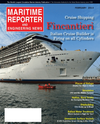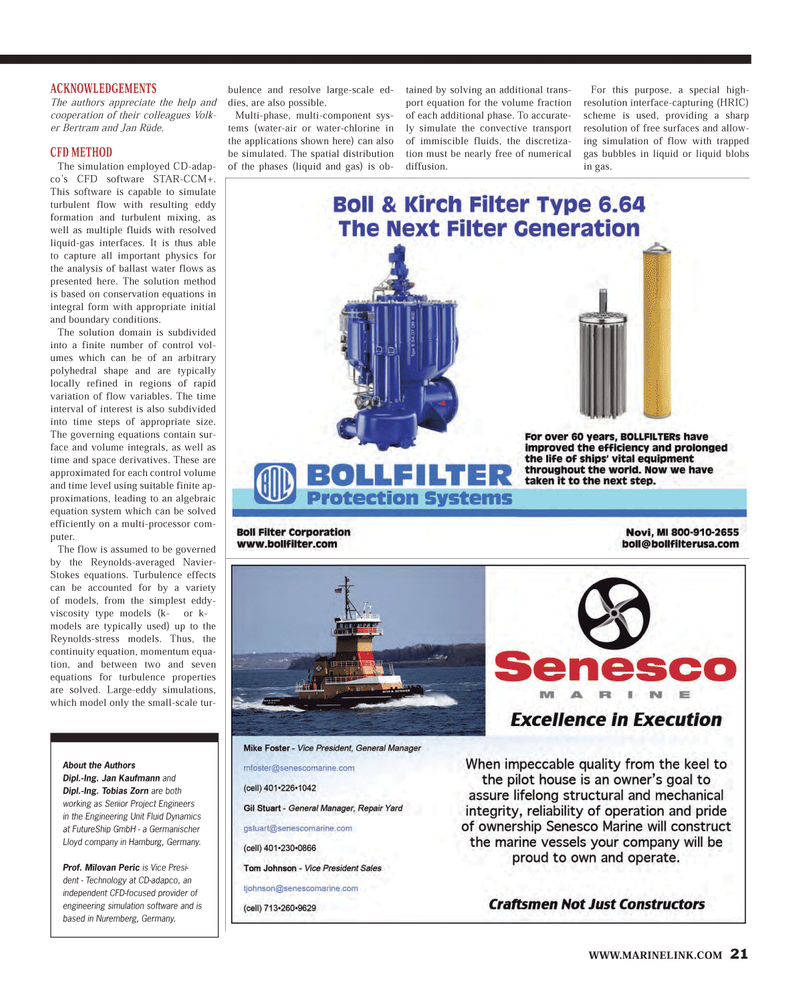
Page 21: of Maritime Reporter Magazine (February 2013)
Cruise & Passenger Vessel
Read this page in Pdf, Flash or Html5 edition of February 2013 Maritime Reporter Magazine
WWW.MARINELINK.COM 21ACKNOWLEDGEMENTSThe authors appreciate the help and cooperation of their colleagues Volk- er Bertram and Jan Rüde.CFD METHODThe simulation employed CD-adap-co?s CFD software STAR-CCM+. This software is capable to simulate turbulent flow with resulting eddy formation and turbulent mixing, as well as multiple fluids with resolved liquid-gas interfaces. It is thus able to capture all important physics for the analysis of ballast water flows as presented here. The solution method is based on conservation equations in integral form with appropriate initial and boundary conditions. The solution domain is subdivided into a finite number of control vol-umes which can be of an arbitrary polyhedral shape and are typically locally refined in regions of rapid variation of flow variables. The time interval of interest is also subdivided into time steps of appropriate size. The governing equations contain sur- face and volume integrals, as well as time and space derivatives. These are approximated for each control volume and time level using suitable finite ap-proximations, leading to an algebraic equation system which can be solved efficiently on a multi-processor com- puter. The flow is assumed to be governed by the Reynolds-averaged Navier- Stokes equations. Turbulence effects can be accounted for by a variety of models, from the simplest eddy-viscosity type models (k- or k- models are typically used) up to the Reynolds-stress models. Thus, the continuity equation, momentum equa-tion, and between two and seven equations for turbulence properties are solved. Large-eddy simulations, which model only the small-scale tur- bulence and resolve large-scale ed- dies, are also possible.Multi-phase, multi-component sys-tems (water-air or water-chlorine in the applications shown here) can also be simulated. The spatial distribution of the phases (liquid and gas) is ob-tained by solving an additional trans-port equation for the volume fraction of each additional phase. To accurate- ly simulate the convective transport of immiscible fluids, the discretiza-tion must be nearly free of numerical diffusion. For this purpose, a special high-resolution interface-capturing (HRIC) scheme is used, providing a sharp resolution of free surfaces and allow-ing simulation of flow with trapped gas bubbles in liquid or liquid blobs in gas.About the AuthorsDipl.-Ing. Jan Kaufmann and Dipl.-Ing. Tobias Zorn are both working as Senior Project Engineers in the Engineering Unit Fluid Dynamics at FutureShip GmbH - a Germanischer Lloyd company in Hamburg, Germany. Prof. Milovan Peric is Vice Presi- dent - Technology at CD-adapco, an independent CFD-focused provider of engineering simulation software and is based in Nuremberg, Germany. MR #2 (18-25).indd 21MR #2 (18-25).indd 212/3/2013 2:12:41 PM2/3/2013 2:12:41 PM

 20
20

 22
22
